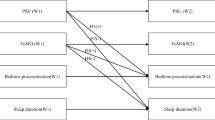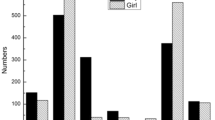Abstract
Background
Using a smartphone in bed (SPiB) before going to sleep is associated with sleep problems; however, it remains unclear whether it is not the duration but rather the individual motives behind the usage that cause the problems. This was studied in late adolescents.
Materials and methods
A total of 201 participants aged 16–21 years were questioned about their sleep and stress as well as their smartphone usage habits in bed and the reasons for this use. The Motives of Smartphone Usage Scale (MSPUS) was developed to measure motives behind phone use such as “use for entertainment”, “avoidance of worries”, “sleep aid” and “fear of missing out (FoMO)”. Sleep was analysed using the Pittsburgh Sleep Quality Index (PSQI), the Insomnia Questionnaire for Adults (IQA), and other parameters; stress was assessed with the Ford Insomnia Response to Stress Test (FIRST). Multiple regression analyses were used to examine the association between the motives of usage, duration of SPiB and sleep parameters. Correlations with stress and differences in sleep reactivity were examined.
Results
The usage motives “entertainment”, “FoMO” and “avoiding worries” predicted a longer smartphone usage duration (SPiB-d). Sleep problems were associated with longer use in general, particularly to avoid worries, but less with use for entertainment. Adolescents with high sleep reactivity did not use their phone longer, but more often because of FoMO and to avoid worrying.
Conclusion
What becomes clear is that smartphone use duration is not the main sleep-disruptive factor. Adolescents with sleep difficulties and stress seem to suppress worries and rumination by using their smartphone in bed. This problem-avoidant use behaviour should be considered in intervention approaches and, correspondingly, active problem-solving behaviour should be trained.
Zusammenfassung
Hintergrund
Die Smartphone-Nutzung im Bett (SPiB) vor dem Schlafen steht mit Schlafproblemen in Verbindung. Dennoch bleibt offen, ob nicht die Dauer, sondern die individuellen Nutzungsmotive die Problematik bedingen. Dies wurde bei Jugendlichen in der späten Adoleszenz untersucht.
Methodik
Es wurden 201 Teilnehmer im Alter von 16–21 Jahren zu Schlaf, Stress sowie Handynutzungsgewohnheiten und -begründungen befragt. Die Motives of Smartphone Usage Scale (MSPUS) wurde entwickelt, um die Nutzungsmotive „Nutzung zur Unterhaltung“, „Ablenkung von Sorgen“, „Einschlafhilfe“ und „fear of missing out“ (FoMO) zu erfassen. Schlaf wurde basierend auf dem Pittsburgh Sleep Quality Index (PSQI), dem Insomnia Questionnaire for Adults (IQA) und anderen Parametern analysiert; der Faktor Stress wurde mithilfe des Ford Insomnia Response to Stress Test (FIRST) eruiert. Mittels multipler Regressionsanalysen wurde der Zusammenhang zwischen Nutzungsmotivation, Nutzungsdauer im Bett und Schlafparametern untersucht. Zusammenhänge mit Stress und Unterschiede in der Schlafreaktivität wurden betrachtet.
Ergebnisse
Mit einer längeren Smartphone-Nutzungsdauer im Bett (SPiB-d) sind die Nutzungsmotive „Unterhaltung“, FoMO und „Ablenkung von Sorgen“ verbunden. Schlafprobleme gehen mit einer tendenziell durchschnittlich längeren Nutzungsdauer und einer ausgeprägteren Nutzung zur Unterdrückung von Sorgen, jedoch weniger mit der Nutzung zu Unterhaltungszwecken einher. Jugendliche mit hoher Schlafreaktivität berichteten nicht, das Handy länger zu benutzen, jedoch mehr aufgrund von FoMO und um Sorgen zu vermeiden.
Schlussfolgerung
Diese Studie verdeutlicht, dass die alleinige Dauer der Handynutzung nicht der primäre schlafbeeinträchtigende Faktor ist. Jugendliche mit Schlafproblemen und Stress versuchen mittels des Smartphones im Bett Sorgen und Grübeln zu unterdrücken. Dieses problemvermeidende Nutzungsverhalten sollte in Interventionsansätzen berücksichtigt werden und entsprechend aktiv bewältigendes Problemverhalten geübt werden.

Similar content being viewed by others
References
Åkerstedt T, Axelsson J, Lekander M, Orsini N, Kecklund G (2013) The daily variation in sleepiness and its relation to the preceding sleep episode—a prospective study across 42 days of normal living. J Sleep Res 22:258–265
Buysse DJ, Reynolds CF, Monk TH, Berman SR, Kupfer DJ (1989) The Pittsburgh sleep quality index: a new instrument for psychiatric practice and research. Psychiatry Res 28:193–213
Cain N, Gradisar M (2010) Electronic media use and sleep in schoolaged children and adolescents: a review. Sleep Med 11:735–742
Carter RP, Hale L, Bhattacharjee D, Paradkar M (2016) A meta-analysis of the effect of media devices on sleep outcomes. JAMA Pediatr 170:1202
Cohen J (1992) A power primer. Psychol Bull 122:155–159
Chung SJ, An H, Suh S (2019) What do people do before going to bed? A study of bedtime procrastination using time use surveys. Sleep 43(4):zsz267. https://doi.org/10.1093/sleep/zsz267
Deursen AJ van, Bolle CL, Hegner SM, Kommers PA (2015) Modeling habitual and addictive smartphone behavior: the role of smartphone usage types, emotional intelligence, social stress, self-regulation, age, and gender. Comput Human Behav 45:411–420
Dieck A, Helbig S, Drake CL, Backhaus J (2018) Validation of the German version of the Ford insomnia response to stress test. J Sleep Res 27(3):e12621. https://doi.org/10.1111/jsr.12621
Dziurzyńska E, Pawłowska B, Potembska E (2016) Coping strategies in individuals at risk and not at risk of mobile phone addiction. Curr Prob Psych 17(4):250–260
Eggermont S, Van den Bulck J (2006) Nodding off or switching off? The use of popular media as a sleep aid in secondary-school children. J Paediatr Child Health 42:428–433
Elhai JD, Hall BJ, Levine JC, Dvorak RD (2017) Types of smartphone usage and relations with problematic smartphone behaviors: the role of content consumption vs. social smartphone use. Cyberpsychology 11(2):artical3. https://doi.org/10.5817/CP2017-2-3
Elhai JD, Yang H, Montag C (2020) Fear of missing out (FOMO): overview, theoretical underpinnings, and literature review on relations with severity of negative affectivity and problematic technology use. Braz J Psychiatry. https://doi.org/10.1590/1516-4446-2020-0870
Elhai JD, Yang H, Dempsey AE, Montag C (2020) Rumination and negative smartphone use expectancies are associated with greater levels of problematic smartphone use: a latent class analysis. Psychiatry Res 285:112845
Exelmans L, Van den Bulck J (2017) Bedtime, shuteye time and electronic media: sleep displacement is a two-step process. J Sleep Res 26(3):364–370
Hale L, Guan S (2015) Screen time and sleep among school-aged children and adolescents: a systematic literature review. Sleep Med Rev 21:50–58
Kahn M, Sheppes G, Sadeh A (2013) Sleep and emotions: bidirectional links and underlying mechanisms. Int J Psychophysiol 89:218–228
Kalmbach DA, Cuamatzi-Castelan AS, Tonnu CV, Tran KM, Anderson JR, Roth T, Drake CL (2018) Hyperarousal and sleep reactivity in insomnia: current insights. Nat Sci Sleep 10:193
Kalmbach DA, Pillai V, Arnedt JT, Drake CL (2016) Identifying at-risk individuals for insomnia using the Ford insomnia response to stress test. Sleep 39:449–456
Kater M, Schlarb AA (2020) Motives of smartphone usage scale (MSPUS): bedtime smartphone use in adolescence
Katz E, Blumler JG, Gurevitch M (1973) Uses and gratifications research. Public Opin Q 37:509–523
LaRose R, Lin CA, Eastin MS (2003) Unregulated Internet usage: addiction, habit, or deficient self-regulation? Media Psychol 5:225–253
Liu QQ, Zhou ZK, Yang XJ, Kong FC, Niu GF, Fan CY (2017) Mobile phone addiction and sleep quality among Chinese adolescents: a moderated mediation model. Comput Human Behav 72:108–114
Mazzer K, Boersma K, Linton SJ (2019) A longitudinal view of rumination, poor sleep and psychological distress in adolescents. J Affect Disord 245:686–696
Owens JA, Dearth-Wesley T, Lewin D, Gioia G, Whitaker RC (2016) Self-regulation and sleep duration, sleepiness, and chronotype in adolescents. Pediatrics. https://doi.org/10.1542/peds.2016-1406
Rzewnicki DI, Shensa A, Levenson JC, Primack BA, Sidani JE (2020) Associations between positive and negative social media experiences and sleep disturbance among young adults. Sleep Health. https://doi.org/10.1016/j.sleh.2020.02.013
Scott H, Biello SM, Woods HC (2019) Identifying drivers for bedtime social media use despite sleep costs: the adolescent perspective. Sleep Health 5:539–545
statista (2019) Smartphone-Besitz bei Kindern und Jugendlichen in Deutschland im Jahr 2019 nach Altersgruppe. https://de.statista.com/statistik/daten/studie/1106/umfrage/handybesitz-bei-jugendlichen-nach-altersgruppen/. Accessed 26 Feb 2020
statista (2020) Statistiken zur Mediennutzung von Jugendlichen. https://de.statista.com/themen/2662/mediennutzung-von-jugendlichen/. Accessed 20 Apr 2020
Scott H, Woods HC (2018) Fear of missing out and sleep: cognitive behavioural factors in adolescents’ nighttime social media use. J Adolesc 68:61–65
Scott H, Woods HC (2019) Understanding links between social media use, sleep and mental health: recent progress and current challenges. Curr Sleep Med Rep 5(3):141–149
Tavernier R, Willoughby T (2014) Sleep problems: predictor or outcome of media use among emerging adults at university? J Sleep Res 23(4):389–396
Thomée S (2018) Mobile phone use and mental health. A review of the research that takes a psychological perspective on exposure. Int J Environ Res Public Health 15(12):2692
Thomée S, Härenstam A, Hagberg M (2011) Mobile phone use and stress, sleep disturbances, and symptoms of depression among young adults—a prospective cohort study. BMC Public Health 11:66. https://doi.org/10.1186/1471-2458-11-66
Thomsen DK, Mehlsen MY, Christensen S, Zachariae R (2003) Rumination—relationship with negative mood and sleep quality. Pers Individ Dif 34:1293–1301
Wolfers LN, Schneider FM (2020) Using media for coping: a scoping review. Commun Res. https://doi.org/10.1177/0093650220939778
Author information
Authors and Affiliations
Corresponding author
Ethics declarations
Conflict of interest
M.-J. Kater and A.A. Schlarb declare that they have no competing interests.
All procedures followed were in accordance with the ethical standards of the responsible institutional ethics committee and with the Helsinki Declaration of 1975 (in its most recently amended version). Informed consent was obtained from all patients included in the study.
Caption Electronic Supplementary Material
11818_2020_272_MOESM2_ESM.docx
Supplementary material 2 Multiple regression analyses of the duration of smartphone usage in bed (SPiB-d) and sleep parameters adjusted for age, gender and individual stress level
Rights and permissions
About this article
Cite this article
Kater, MJ., Schlarb, A.A. Smartphone usage in adolescents – motives and link to sleep disturbances, stress and sleep reactivity. Somnologie 24, 245–252 (2020). https://doi.org/10.1007/s11818-020-00272-7
Received:
Accepted:
Published:
Issue Date:
DOI: https://doi.org/10.1007/s11818-020-00272-7




